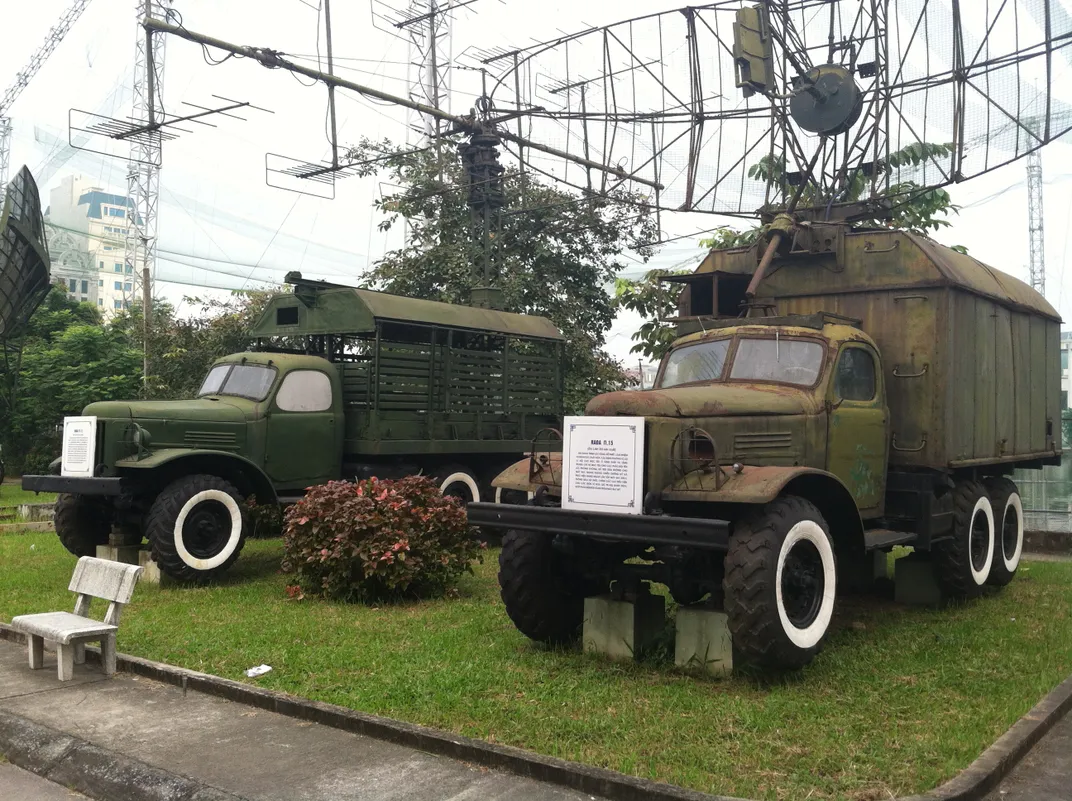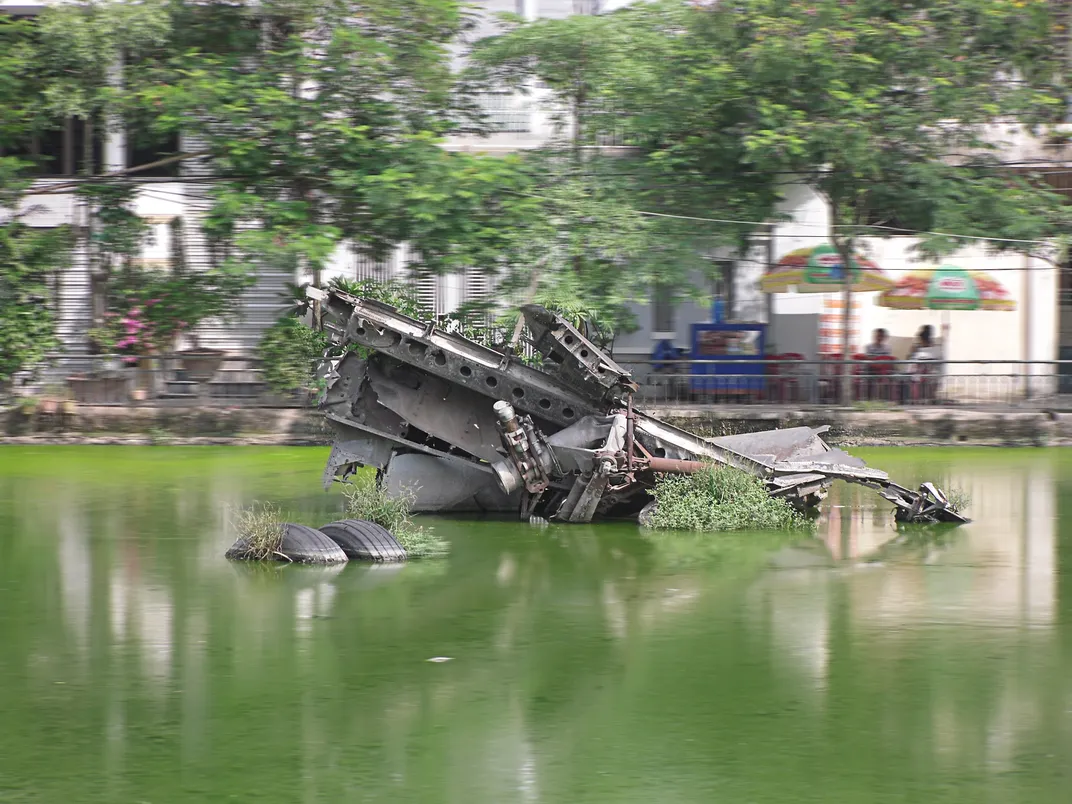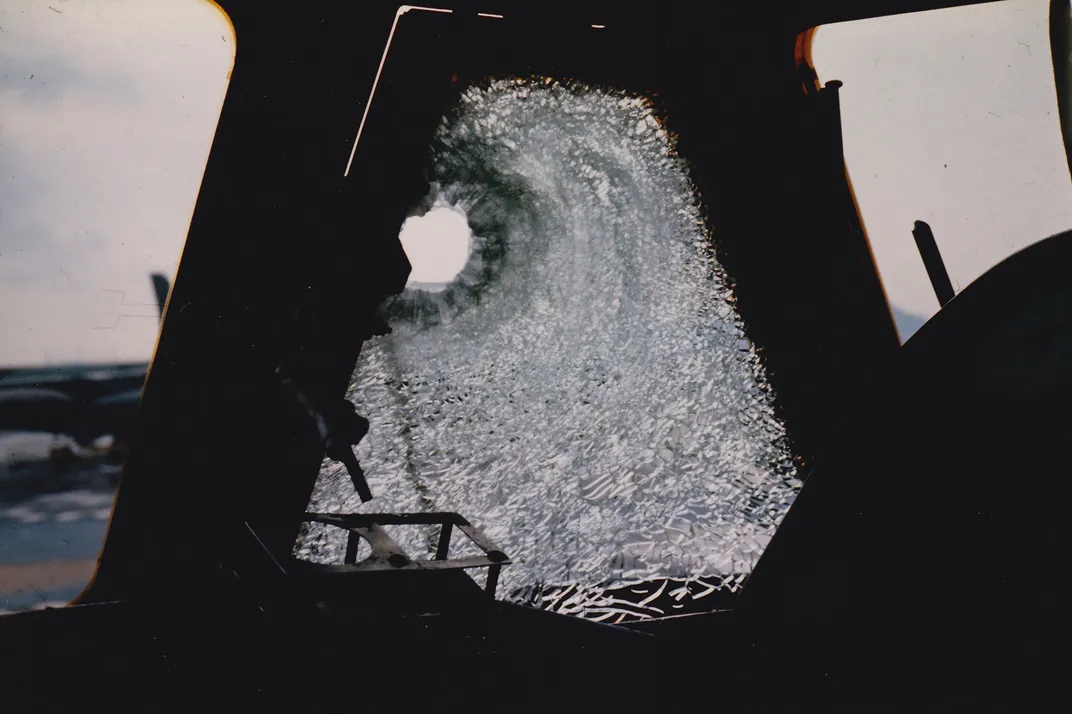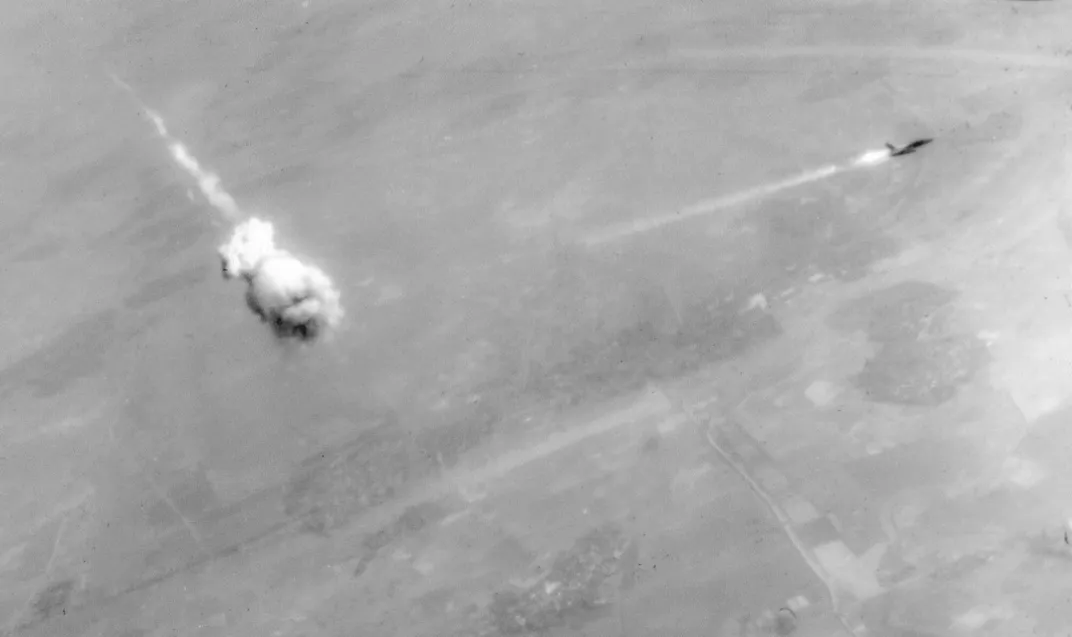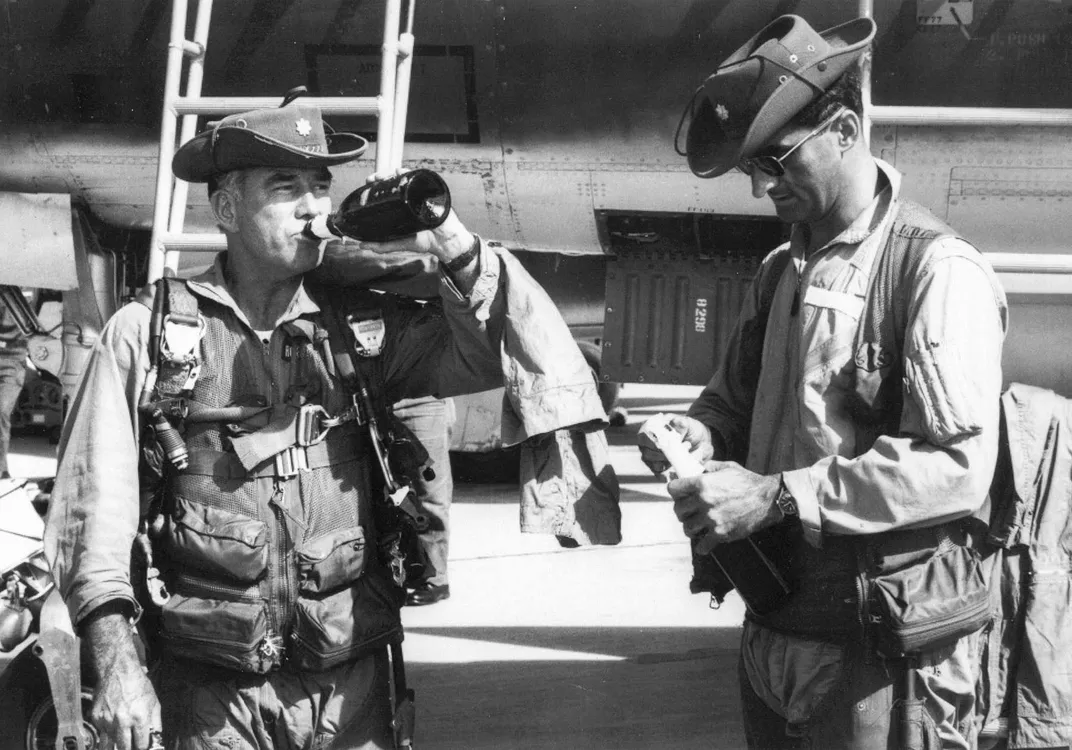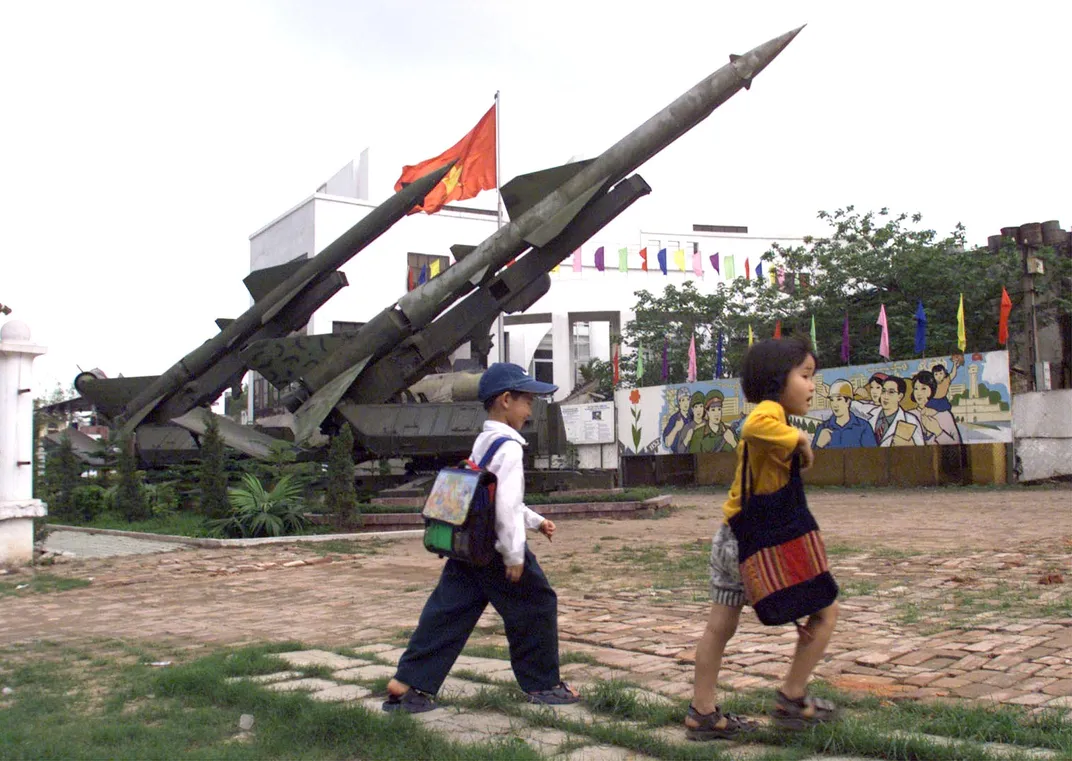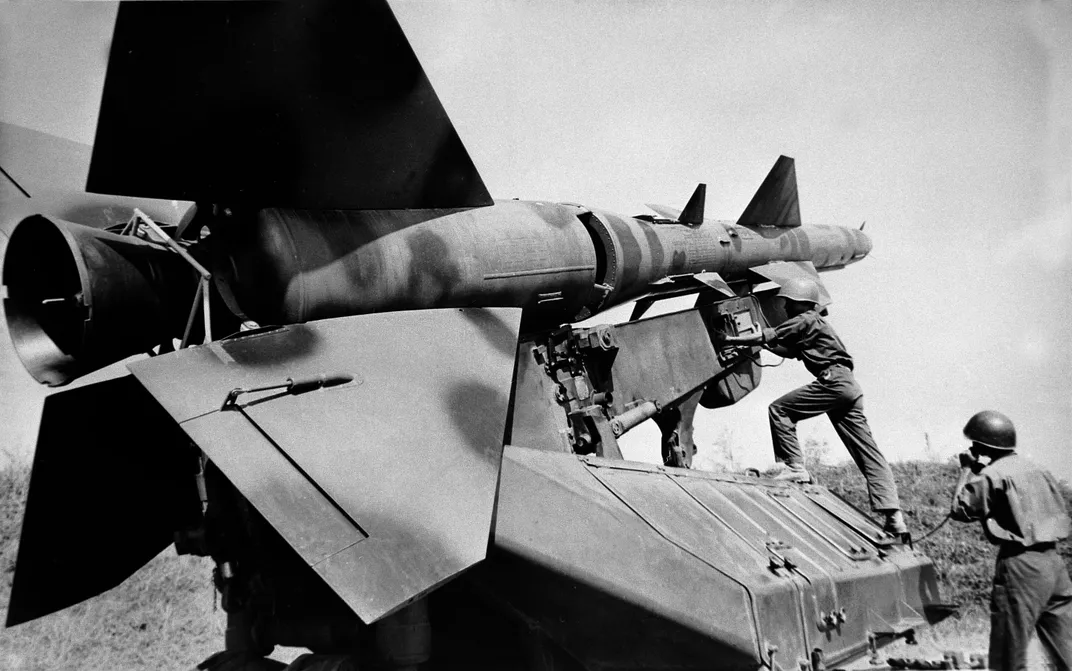The Missile Men of North Vietnam
A look at the air war waged from the ground.
:focal(1214x3157:1215x3158)/https://tf-cmsv2-smithsonianmag-media.s3.amazonaws.com/filer/ee/cd/eecdea11-d3c5-4da3-9949-1509b377b8c6/14d_aug14_sa2crew_live.jpg)
What does it feel like to push a button, launch a surface-to-air missile, and blow a B-52 bomber out of the sky? Ask Nguyen Van Phiet. As a young North Vietnamese military officer, his SA-2 rockets were credited with downing four of the giant Boeing Stratofortresses during U.S. raids on and around Hanoi in December 1972.
More than 40 years later, sitting in his comfortable Hanoi rowhouse, the wizened, soft-spoken Phiet, 76, a retired lieutenant general and former deputy commander of Vietnam’s air defense force, shows little emotion when recalling those deadly days. “The Americans were disturbing our freedom,” he says in Vietnamese as we sip tea from delicate china cups at his dining room table. “I was fulfilling my responsibility to the nation.”
Among the many weapons in North Vietnam’s anti-aircraft arsenal, few were more feared than the type of missiles Phiet commanded: the Russian-built S-75 Dvina (the SA-2 “Guideline,” in NATO parlance). U.S. combat crews likened the two-stage, 35-foot-long SA-2 to a flying telephone pole. The 5,000-pound missile had an effective range of about 21 miles, streaking toward its target at more than four times the speed of sound, up to an altitude of 90,000 feet to deliver a 430-pound fragmentation warhead that could shred anything within its nearly 300-yard maximum blast radius.
In 1960, an SA-2 brought down Francis Gary Powers’ U-2 reconnaissance aircraft over the Soviet Union. Seven years later, an SA-2 knocked the right wing off of John McCain’s carrier-based A-4 Skyhawk, forcing McCain to eject and parachute, badly injured, into Hanoi’s Trúc Bach Lake, where he was fished from the water and taken prisoner. And it was the SA-2 that delivered what the Vietnamese today regard as their greatest aerial triumph: the destruction of more than a dozen B-52s during the so-called Christmas bombings of 1972. A gleaming museum in Hanoi celebrates the achievement; its name, the B-52 Victory Museum.
Time, vegetation, and urban development have erased virtually any trace of the mobile SA-2 sites that once ringed Hanoi and made its airspace among the most heavily defended in the world, but examples of the missiles themselves aren’t hard to find in the Vietnamese capital. On the grounds of military museums in what was once called North Vietnam, they stand like the statues of Greek gods. As an American, seeing the weapons that shot down so many U.S. airmen was jarring, if not a little unnerving.
***
Nguyen Van Pheit joined the North Vietnamese military in 1960. Five years later, as a young lieutenant, he was sent to the Soviet Union along with about 1,000 of his countrymen for SA-2 training. For nine months, they studied and drilled 14 hours a day, seven days a week, learning enough Russian that many became conversant with their instructors. The Soviets regularly served them bacon. Used to a Vietnamese diet rich in rice and vegetables, Phiet initially found the meat unappetizing, but he eventually got used to it. The culmination of his training was launching SA-2s at two unmanned aircraft. Phiet and his crew nailed both of the targets and toasted their hits with champagne.
After graduating from missile school, Phiet was deployed to Hoa Binh Province, southwest of Hanoi, to work on the city’s outer ring of air defense. Like the other SA-2s deployed to defend the North, the six missiles assigned to Phiet were arrayed in a rough circle on mobile, truck-towed launchers, with each missile positioned about a mile from its control and support vehicles.
A typical SA-2 battery relied on a truck-mounted Spoon Rest acquisition radar unit, which provided target location data to a rudimentary computer, and Fan Song guidance radar, which aided in missile guidance as well as target acquisition. To operate each SA-2, a minimum of five primary crewmen, in addition to maintenance and other support personnel, were required: three radar operators, one controller, and a battery commander.
On the afternoon of October 22, 1966, with his Soviet advisers looking on, Phiet received a report from headquarters in Hanoi that approximately two dozen U.S. warplanes were inbound from Thailand. When the formation was within about 37 miles of his position, says Phiet, he ordered his radar operators to turn on their scopes, then reported back to his superiors that he’d electronically acquired the enemy formation. He was instructed to fire one missile when ready. His SA-2 roared off its launch rail. Though he was confident in his training and abilities, Phiet says he was nonetheless surprised when it hit its intended target, a U.S. Air Force F-105 Thunderchief.
U.S. records show that no F-105s were lost on that day over North Vietnam. The day before, however, a “Thud” assigned to the 469th Tactical Fighter Squadron, based in Thailand, was seen exploding in a fireball on a bombing mission south of Hanoi. The pilot, Captain David J. Earll of Dallas, Texas, was initially reported missing in action. Twenty years later, his remains were located.
“The whole aircraft exploded,” Phiet remembers, gazing placidly into space.
Like other SA-2 crewmen, Phiet and his soldiers rarely got a day off or were granted leave. When they weren’t on alert, they dozed inside their trucks or slept on the ground outside. The army supplied them with rice and other rations, which were often augmented with fresh meat and produce that North Vietnamese civilians living nearby provided.
The life of a missileer was grueling, often tedious, and occasionally terrifying, but retired Colonel Nguyen Dinh Kien, 67, a former SA-2 fire control officer, says that he and his comrades had it relatively easy compared to the thousands of North Vietnamese soldiers sent south to fight. Those troops were often gone for years, says Kien, and many never returned.
Kien was a college student studying agricultural engineering in 1965 when he joined the North Vietnamese army and spent four months training on the SA-2 before being assigned to a missile battalion south of Hanoi. Soviet technical advisers came by once a month, he says, to make sure everything was working properly and to answer questions, of which there was never any shortage. With its solid-fuel booster and liquid-fuel second stage, the SA-2 was a complex weapon requiring regular maintenance, as did each battery’s radar systems. Kien recalls that the Soviets told the crewmen that each SA-2 cost the equivalent of about $100,000—more than $700,000 today.
On February 28, 1968, Kien got his first taste of real combat. After tracking a U.S. Navy A-6 Intruder for 12 miles, he launched two SA-2s. Both missed. The Intruder had used “annoying signals” to blur his crew’s radar, he says. He and his crew then waited what seemed like hours for the Intruder to counterattack. “I was afraid the entire time to be hit by the enemy,” he remembers, but the A-6 crew never attacked.
Ralph Wetterhahn is a retired Air Force colonel (and Air & Space magazine contributor) who flew F-4C Phantoms on 180 missions over North Vietnam in three combat tours. Later, he flew Navy A-7E Corsairs. By 1966, he says, the jets were being outfitted with radar homing and warning receivers, known to air crews as “RHAW gear.” An antenna mounted atop the aircraft’s tail sensed the search and tracking modes of the radar used to guide SA-2s. The information was displayed on a small cockpit scope that looked like a bullseye with three concentric rings. When enemy radar swept the airplane, a strobe would appear on the scope indicating the aircraft’s bearing and its distance from the radar site. A “three ringer” meant that the site was dangerously close. At launch, a different signal was received and a red launch light came on, accompanied by a tone in the pilot’s headset. There were also strobes for the radars that controlled 57-mm and 85-mm anti-aircraft guns.
“At times over Hanoi,” Wetterhahn recalls, “the scope would be alive with strobes, and the headset chirped like mad.”
Eventually, Phantoms were outfitted with QRC-160 wing pods designed to jam SAM radars. The units were largely effective, but occasionally broke down.
As U.S. electronic countermeasures improved, along with more effective evasive techniques—American pilots learned to outmaneuver the SA-2 by diving toward it, then pulling up sharply after the missile turned to track them—it became increasingly challenging for North Vietnamese gunners to fire effectively without drawing counter-fire. Of particular concern was the Americans’ AGM-78 anti-radiation missile.
Fired from F-4G and F-105G “Wild Weasel” aircraft outside the effective range of SA-2 radars, the highly maneuverable AGM-78 missile, which was capable of turning 180 degrees after being launched, could home in on North Vietnamese radar units even after they ceased emitting.
Phiet says that to reduce their exposure, he and his fellow officers would play a cat-and-mouse game, keeping their radars on until an inbound warplane was about 25 miles away. They would then turn off the radar, calculating the aircraft’s speed, distance, and last plotted direction until the aircraft was little more than a mile away. The SA-2 launcher, which was reusable, could be swiftly rotated a full 360 degrees. Crews would then turn on the guidance radar and attack.
The missile launchers were wheeled, allowing them to be relocated quickly. SAM crews could, in fact, pack up an entire site—usually made up of six missiles—in about four hours, but Phiet says their carefully camouflaged locations shifted only when it was believed the missiles had been spotted by U.S. surveillance aircraft.
Phiet says that over the course of the war he launched 89 SA-2s from various locations around Hanoi. He reports hitting 21 aircraft, including the F-105 that was his first kill, the four B-52s he was credited with shooting down in December 1972, an F-4E Phantom, and one propeller-driven, AD-6 Skyraider. His marksmanship could not be readily confirmed. However, if his claims are true, they would be nothing short of remarkable, considering that any SA-2 finding its mark was relatively rare, U.S. war records show.
As the war dragged on, SA-2 launches increased from a monthly average of about 30 in 1965 to 220 in 1967-1968, while the weapon’s effectiveness declined precipitously. According to Kenneth P. Werrell’s Archie, Flack, AAA, and SAM: A Short Operational History of Ground-Based Air Defense, downing one U.S. aircraft in 1965 took nearly 18 SAM launches. By 1968, the number was 107.
Phiet says that batteries to which he was assigned were directly attacked 10 times; the worst assault happened on September 4, 1972, when both Phiet and Kien, who by then had joined Phiet’s battery, fired at and missed an inbound F-4. The Americans, in turn, launched an AGM-78, killing a 22-year-old soldier, whose heart, Kien says, was pierced by shrapnel as he sat in a radar truck. Phiet was hit in the back and spent a month in a hospital.
“The hardest part was the next day,” says Kien. “The dead man’s wife came to visit him and didn’t know he’d been killed. We lied and told her he’d been called away temporarily.”
North Vietnamese missile veterans like Kien and Phiet aren’t particularly anxious to talk to an American journalist. Officials at Hanoi’s Foreign Press Center wanted $1,000 to set up interviews for this story. Fortunately, I’d made the acquaintance of Dan Cherry, a retired U.S. Air Force brigadier general who counts among his friends a former MiG-21 pilot, Nguyen Hong My, whom Cherry shot down during the war (see “My Enemy, My Friend,” Apr./May 2009). Hong My is acquainted with a prominent Vietnamese journalist who, in turn, introduced me to Phiet. The general persuaded Kien to meet with me.
It’s easy to forget amid Hanoi’s bustle and thriving capitalism that Vietnam remains an authoritarian communist state. The government’s tight control of its message became clear when I went to visit another former SA-2 crewman, Ngo Xuan Chien, at the tiny, windowless apartment he shares with his wife down a dark, dank passageway, just off the city’s fashionable Bà Trieu Street.
I’d met the wispily bearded Chien, 74, while touring the Vietnam People’s Air Force Museum in Hanoi with Hong My and his British-educated nephew, Duc, who’d volunteered to be my interpreter. Chien, with his three-year-old grandson in tow and garbed in a shirt festooned with war medals, approached us as we stood near an SA-2 and said he too was visiting the museum for the first time. When Duc informed him that I was a writer from the United States, he smiled and shook hands vigorously. Chien had been a middle-school instructor teaching Vietnamese literature before joining the North Vietnamese army in 1964 and being assigned to an SA-2 battery. His job was to maintain the missiles and help prepare them for launch.
“We knew exactly when and from where the American aircraft approached,” he said proudly, “and we were prepared.” Chien told me his military service ended when he suffered a debilitating head wound during a 1970 B-52 strike. These days, he lives on a monthly government pension equivalent to about $140—slightly less than the pension his wife, a retired teacher, receives.
Chien had asked me to deliver some photos I’d taken of him and his grandson that day at the museum. When I arrived at his home a week or so later, his demeanor had changed radically. Gone was his warm smile, replaced by a palpable edginess. He’d been instructed by local authorities, he said, to tell me nothing more. He directed me to the B-52 Victory Museum for any questions on missile operations during the war.
The Victory Museum, its main entrance flanked by a brace of camouflaged SA-2s, houses a hodgepodge of war-related photos and memorabilia, much of which has little to do with B-52s. The surrounding grounds afford a vast collection of artifacts that are significantly more on point. They tell the story of Hanoi’s attempt to defend itself using principally SA-2s against what U.S. military planners code-named Operation Linebacker II and what the Vietnamese refer to today as “Dien Bien Phu in the air”—comparing it to their decisive defeat of colonial French ground forces in 1954.
After peace talks stalled, the Nixon administration had ordered raids on Hanoi and Haiphong Harbor to the north. It was hoped that by unprecedented, concentrated bombing, North Vietnam would be forced to return to the bargaining table and negotiate an end to U.S. involvement in the war. More than 200 Strategic Air Command B-52s based on Guam and in Thailand were given the job, along with hundreds of supporting Air Force, Navy, and Marine warplanes whose crews jammed radar and attacked anti-aircraft gun positions.
For Phiet and his SA-2 crews, the start of the bombing campaign brought plenty of anxiety. “We all feared the B-52 at first because the U.S. said it was invincible,” he says. “But after the first night, we knew the B-52 could be destroyed just like any other aircraft. The U.S. said they wanted to bomb Vietnam back to the Stone Age. This was a mistake. You cannot use power to destroy the will of the people.”
If American military planners erred in choreographing the 11-night bombing campaign, author Phil Chinnery wrote in Air War in Vietnam, it was at the outset, when bombers were assigned routes and altitudes that varied little from one wave to the next. The B-52s flew above 30,000 feet and attacked in-trail, with a mile or more between each airplane. As a result, SA-2 crews were able to plot the B-52s’ movements without having to turn on their radars, launching salvos of missiles in the general direction of the bomber stream with virtual impunity. In all, according to Chinnery, the North Vietnamese fired 1,242 missiles. Fifteen B-52s were destroyed (the North Vietnamese claim to have shot down 34), resulting in the deaths of 43 airmen. Another 49 Americans were captured. Vietnamese officials reported more than 1,600 civilians killed as a result of the bombings and some 2,000 homes destroyed.
Despite the casualties, many historians believe that Linebacker II was strategically successful. Damage to North Vietnam’s rail system, petroleum reserves, and electrical power production was extensive. Perhaps more significantly, the B-52 strikes had depleted Hanoi’s stock of SA-2s. With few missiles left to defend itself from high-altitude bombardment, North Vietnam within weeks negotiated a settlement that soon led to the end of U.S. involvement in South Vietnam.
One poignant reminder of that violent period can be seen today in tiny Huu Tiep Lake, northwest of downtown Hanoi. There, jutting prominently from water thick with green algae, rests a large piece of the landing gear from a B-52 felled by an SA-2 on the night of December 27, 1972.
Nguyen Hoai Giang, 34, who runs the B-52 Café across the street from the lake and whose father served as a pilot in the war, is well-versed in what that night was like. Plummeting wreckage from the stricken bomber killed four neighborhood residents in their beds, she says, and narrowly missed an ancient Buddhist pagoda, which still stands a block away.
“Times change,” I tell Giang as she serves me iced coffee on her café’s patio. “America and Vietnam are no longer enemies. Why not remove the wreckage from the lake?”
“It is important to save the image of war,” she replies in halting English, choosing her words carefully, “so that people do not forget.”
About a mile from the lake, outside the Vietnam Military History Museum, an SA-2 on a rusting launcher points skyward, a testament to a clash of arms and ideologies that ended before most of Vietnam’s 93 million citizens were even born. I watch on a warm autumn afternoon as a young father tries without success to get his rambunctious son and daughter to stand still so he can snap their photo in front of the missile. I’m reminded of Phiet’s response to a question I’d asked him when we’d met, about how significant a role he believed the SA-2 played in the outcome of the war. “The equipment was important,” Phiet told me, “but humans will always be more important.”
Where missiles once roared, the skies above Hanoi on this day are a tranquil, hazy blue. Standing outside the museum, I try to imagine what it all must have sounded like: the shriek of rockets, the terrible cacophony of exploding bombs, and falling warplanes. All I can hear, though, is the raucous laughter of children.
